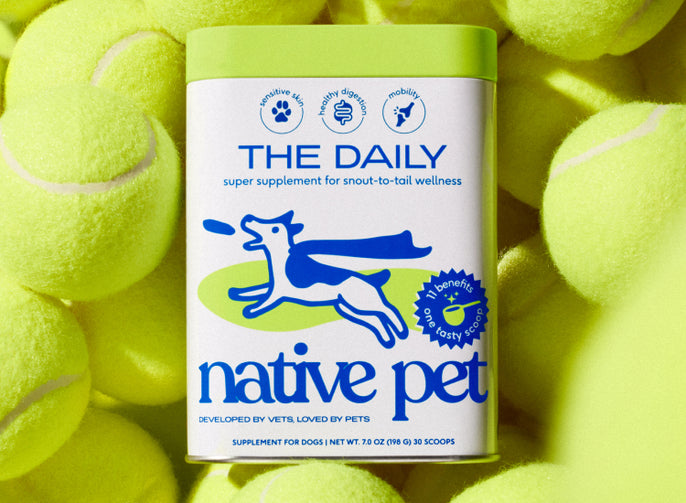Dog joint pain often comes on as our best friends age, but this symptom can affect any dog at any age — and it's relatively common. According to the American Animal Hospital Association, as many as one in five dogs will develop joint problems at some point in their life.
When a young dog develops joint pain, dog owners often recognize it as abnormal and are quick to seek help from a doctor of veterinary medicine, DVM. But even in older dogs, joint pain isn't normal — it's usually a sign of an underlying health problem.
This condition affects not only our dog's quality of life. It can also affect how long they live. Lameness, or a loss of mobility, can lead to obesity and a host of other health problems — ultimately decreasing our dog's lifespan.
Addressing joint health issues early helps keep our dogs mobile and healthy. Here's how to recognize dog joint pain and find the right treatment options for your best friend.
Signs of Dog Joint Pain

There are two types of dog joint pain: acute and chronic. Acute joint pain starts suddenly and is usually caused by an injury. This type of joint pain is easier to recognize because your dog will go from active one minute to inactive the next.
Chronic joint pain is harder to recognize because it usually comes on gradually. Even attentive pet parents might not notice if their dog slows down a little. But this means chronic joint issues often go unaddressed until they become severe.
Identifying joint problems early can help you protect your dog's joints from further damage and keep your pup active. If you think you notice any of these signs — even if they seem minor — talk to your vet.
- Irritability: You may notice changes in your dog's mood, including additional crankiness, especially when they interact with other dogs or are touched near affected joints.
- Decreased energy: If your dog spends more of the day napping and less of the day by your side, this could be a sign of joint pain or another illness.
- Stiffness: Your dog might be slower to get up or change positions. This symptom is sometimes more noticeable in the morning or after a long nap.
- Decreased interest in daily activities: If your dog no longer wants to fetch, play, or go for walks, it's often a sign of joint issues.
- Decreased range of motion: You may notice your dog struggling to scratch an itch, reach a toy, climb on or off the couch, or jump in the car.
- Licking the affected joint: Much like how a dog will lick other injuries, they might lick a joint that's causing them pain. This is a form of self soothing.
- Limping: If your dog favors one side when they walk or lifts one paw slightly off the ground when they stand, it's often a sign of joint pain.
- Decreased muscle mass: If a dog has been experiencing joint pain for a while, they may stop using their affected leg and start favoring the legs that don't cause them pain. This lack of use will lead to decreased muscle mass around the affected joint.
- Lameness: If your dog has become sedentary and struggles to move, this is a sign of severe joint pain that needs immediate veterinary attention.
Causes of Joint Pain

There are a variety of health issues that can cause joint pain in dogs. But the majority of these issues fall into one of two categories: developmental or degenerative disorders.
Developmental Joint Problems
Developmental joint issues are caused by your dog's anatomy. Essentially, these types of issues occur for genetic reasons. Even though they might become more problematic as your pet ages, they are part of your dog's makeup from puppyhood.
Common developmental disorders include elbow dysplasia and hip dysplasia. These issues affect some dog breeds more than others. German Shepherds, Golden Retrievers, and Labradors have a higher risk.
In general, large breed dogs are more prone to joint issues than small breed dogs because of the added weight their joints carry.
Degenerative Joint Problems
Degenerative joint issues are caused by illnesses or injuries that accumulate overtime. Osteoarthritis, a common example, mostly affects senior dogs. There are also other forms of arthritis in dogs — like immune-mediated arthritis — that can start at any age.
Arthritic dogs suffer from degeneration in the cartilage around their joints. This causes their bones to rub against each other and leads to joint inflammation, which causes joint pain.
Lifestyle factors can also contribute to joint health issues. Past injuries, like joint dislocations and ligament tears, can lead to joint pain, as can wear and tear from repeated high-impact exercise. However, high-impact exercise isn't nearly as big of a contributor to joint pain as lack of exercise.
One of the biggest risk factors for dog joint pain is obesity, and joint problems are just one of the many health issues caused by obesity in dogs.
How to Relieve Dog Joint Pain

The best way to treat joint pain in dogs is to combine multiple therapies. For example, you might try combining physical therapy with all-natural pet supplements and a weight loss plan. Your vet can help you identify the best options for your pet based on the cause and severity of their joint pain.
Here's a look at the treatments available to your dog — from natural pain relief options to lifestyle changes and veterinary procedures.
Weight Management
If your dog is overweight, one of the most important things you can do for their joint health and their overall health is start them on a weight loss plan. Bringing your dog down to a healthy weight will reduce the amount of pressure on their joints and improve their overall wellness.
Low-Impact Exercise
High-impact exercise can put increased strain on your dog's joints when they're already hurting, but continued exercise is still essential to keep your dog mobile and protect their range of motion. Opt for low-impact exercise like walking and swimming. Even if your dog can only walk as far as the mailbox, it's probably better than sitting on the couch.
Hot and Cold Therapy
Heat packs and ice packs can help our dogs in the same way they help us. Use cold therapy to decrease inflammation (it's especially helpful after exercise). Use heat therapy to loosen your dog's muscles, especially before exercise or in the morning when your dog is at their stiffest).
Try placing heat or ice packs on your dog's achy joints when they are lying down and relaxing. If they move away when you apply heat or ice, you can tie the hot or cold pack on using a handkerchief or bandage. Apply ice for 10 minutes at a time and heat for 20 minutes at a time.
Physical Therapy
Many veterinary clinics now offer physical therapy treatments for dogs — from balance therapy to hydrotherapy. These treatments may restore some range of motion and help keep the joint pain from getting worse.
Acupuncture
In acupuncture, a trained practitioner inserts thin needles into their skin. Studies have found acupuncture can effectively reduce some pain markers. We still don't fully understand how it works, but a theory is that acupuncture affects the nerve endings, which send pain signals to the brain.
Glucosamine and Chondroitin
Glucosamine and chondroitin are two of the most common ingredients in traditional joint supplements for dogs. They're both generally safe for dogs when properly prescribed and administered. However, there isn't yet enough research to support their efficacy against joint pain. As dog owners ourselves, we would need to take a try-and-see approach to determine if it worked for our own pets.
Fish Oil
Fish oil is one supplement that is strongly supported by research. The omega-3 fatty acids in fish oil help lubricate and protect our dog's joints. Add fish oil to your pet's diet with Native Pet Omega Oil, sourced from wild-caught pollock and salmon.
Green-Lipped Mussels
Green-lipped mussels are the main ingredient in Native Pet Hip + Joint Supplements. They're one of the only all-natural whole foods that showed promise for supporting joint health in an analysis of scientific research on the subject. This superfood is a natural source of glucosamine, chondroitin, and omega-3 fatty acids.
Turmeric
Turmeric is an all-natural anti-inflammatory. It's well researched in both dogs and humans. In one study, it helped decrease pain markers in dogs with osteoarthritis.
To feed this healing spice to your dog, make a paste from turmeric, a pinch of black pepper (to make the turmeric more bioavailable), and fish oil. Give your dog 1/4 to 1 teaspoon of turmeric paste at mealtime, depending on their size.
NSAIDs
NSAIDs, or non steroidal anti-inflammatory drugs, are similar to over-the-counter pain medications like Tylenol and Advil, but they're formulated specifically for our dogs. Note: Dogs shouldn’t be given human pain medications. They metabolize medicine differently from us, and some human medicines are toxic to our pets.
These medications are available by prescription from your veterinarian. When you talk to your vet about getting NSAIDs for your dog, ask about potential side effects so you can make sure they're right for your pet.
Surgery
If your dog's joint pain is severe, they may need surgery to help them regain their range of motion. Your veterinarian can help you navigate the surgical options. If you're considering surgery, ask your vet how to prepare your dog for surgery, what to expect from the recovery process, and whether your pet is healthy enough to undergo anesthesia.
Keep Your Best Friend Moving

Protecting your dog's joints helps preserve their overall health and vitality. If you notice symptoms of joint pain, including irritability, stiffness, decreased range of motion, limping, or lameness, talk to your DVM as soon as possible.
There are many treatments for dog joint pain, from holistic remedies like fish oil and joint supplements to lifestyle interventions like weight loss and exercise. Whichever you choose, act sooner rather than later.
Joint damage can accumulate over time, so start your pet on the path to healthier joints as soon as you notice that first twinge of dog joint pain — or even before problems start. It's never too soon to protect your pet's joints.
For more information about your dog's health and wellness, visit the Native Pet blog.

